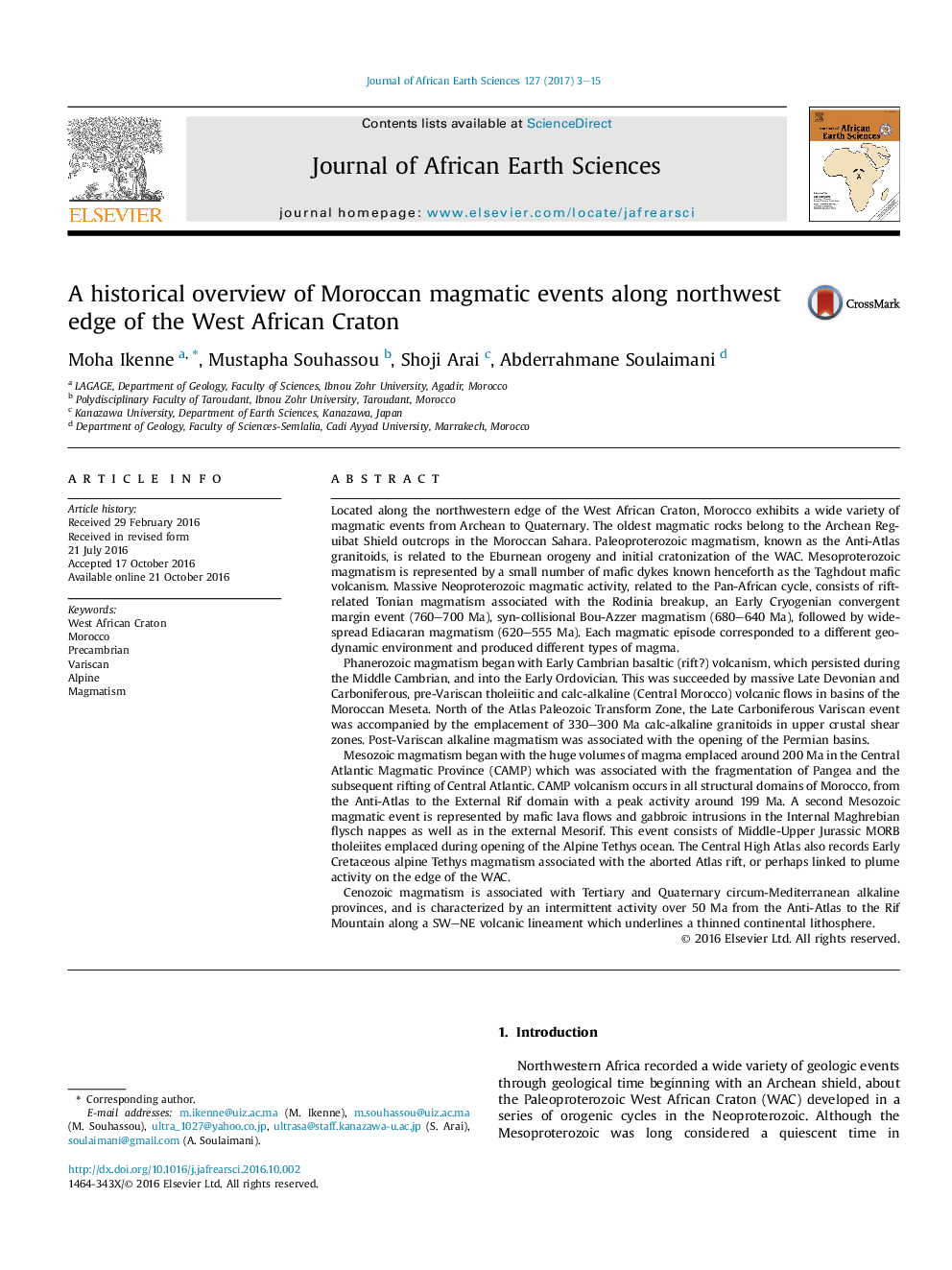| کد مقاله | کد نشریه | سال انتشار | مقاله انگلیسی | نسخه تمام متن |
|---|---|---|---|---|
| 5785750 | 1640181 | 2017 | 13 صفحه PDF | دانلود رایگان |
- Long geological history of Morocco as attested by the Archean rocks exposed in the Reguibate Shield.
- Continental accretion and “Cratonization” of the West African Craton during Proterozoic mainly recorded by granitic magmatism coeval with Eburnian orogeny.
- Mesoproterozoic events recently outlined in the Anti-Atlas can be interpreted in terms of geodynamics.
- Amalgamation and break-up of supercontinents are recorded by magmatic events during Neoproterozoic and Phanerozoic.
Located along the northwestern edge of the West African Craton, Morocco exhibits a wide variety of magmatic events from Archean to Quaternary. The oldest magmatic rocks belong to the Archean Reguibat Shield outcrops in the Moroccan Sahara. Paleoproterozoic magmatism, known as the Anti-Atlas granitoids, is related to the Eburnean orogeny and initial cratonization of the WAC. Mesoproterozoic magmatism is represented by a small number of mafic dykes known henceforth as the Taghdout mafic volcanism. Massive Neoproterozoic magmatic activity, related to the Pan-African cycle, consists of rift-related Tonian magmatism associated with the Rodinia breakup, an Early Cryogenian convergent margin event (760-700Â Ma), syn-collisional Bou-Azzer magmatism (680-640Â Ma), followed by widespread Ediacaran magmatism (620-555Â Ma). Each magmatic episode corresponded to a different geodynamic environment and produced different types of magma.Phanerozoic magmatism began with Early Cambrian basaltic (rift?) volcanism, which persisted during the Middle Cambrian, and into the Early Ordovician. This was succeeded by massive Late Devonian and Carboniferous, pre-Variscan tholeiitic and calc-alkaline (Central Morocco) volcanic flows in basins of the Moroccan Meseta. North of the Atlas Paleozoic Transform Zone, the Late Carboniferous Variscan event was accompanied by the emplacement of 330-300Â Ma calc-alkaline granitoids in upper crustal shear zones. Post-Variscan alkaline magmatism was associated with the opening of the Permian basins.Mesozoic magmatism began with the huge volumes of magma emplaced around 200Â Ma in the Central Atlantic Magmatic Province (CAMP) which was associated with the fragmentation of Pangea and the subsequent rifting of Central Atlantic. CAMP volcanism occurs in all structural domains of Morocco, from the Anti-Atlas to the External Rif domain with a peak activity around 199Â Ma. A second Mesozoic magmatic event is represented by mafic lava flows and gabbroic intrusions in the Internal Maghrebian flysch nappes as well as in the external Mesorif. This event consists of Middle-Upper Jurassic MORB tholeiites emplaced during opening of the Alpine Tethys ocean. The Central High Atlas also records Early Cretaceous alpine Tethys magmatism associated with the aborted Atlas rift, or perhaps linked to plume activity on the edge of the WAC.Cenozoic magmatism is associated with Tertiary and Quaternary circum-Mediterranean alkaline provinces, and is characterized by an intermittent activity over 50Â Ma from the Anti-Atlas to the Rif Mountain along a SW-NE volcanic lineament which underlines a thinned continental lithosphere.
Journal: Journal of African Earth Sciences - Volume 127, March 2017, Pages 3-15
